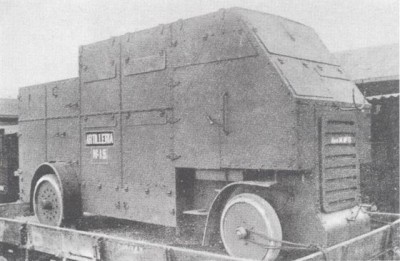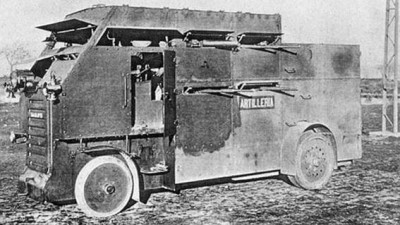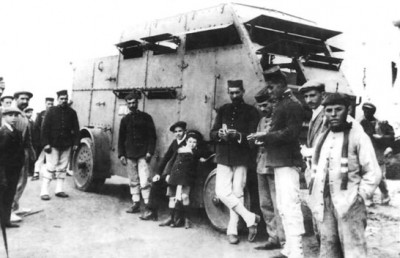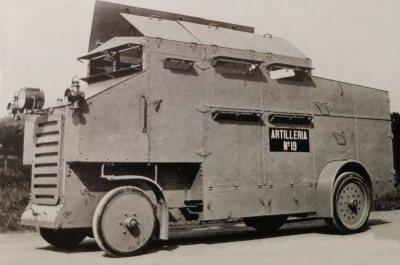| Název: Name: | Schneider-Brillié | Schneider-Brillié |
| Originální název: Original Name: | Schneider-Brillié | |
| Kategorie: Category: | obrněný transportér | armoured personnel carrier |
| Výrobce: Producer: | DD.MM.1910-DD.MM.1915 Schneider & Cie., Le Creusot ? | |
| Období výroby: Production Period: | DD.MM.1910-DD.MM.1915 | |
| Vyrobeno kusů: Number of Produced: | 2 (?) | |
| Prototyp vyroben: Prototype Built: | DD.MM.RRRR | |
| Osádka: Crew: | 6 | |
| Přepravní kapacita: Seating Capacity: | 10 osob/troops | |
| Technické údaje: Technical Data: | ||
| Bojová hmotnost: Combat Weight: | 9350 kg | 20613 lb |
| Celková délka: Overall Length: | cca 6000 mm | cca 19 ft 8 ¼ in |
| Celková šířka: Overall Width: | 2250 mm | 7 ft 4 ⅝ in |
| Celková výška: Overall Height: | cca 4000 mm | cca 13 ft 1 ½ in |
| Světlá výška: Ground Clearance: | ? mm | ? |
| Pancéřování: Armour: | 5 mm | 5 mm |
| Pohon: Propulsion: | ||
| Typ: Type: | Brillié (vodou chladený zážihový 4-valec objemu ? cm3) | Brillié (4 cyl, gasoline, water cooled, ? ccm) |
| Výkon: Power: | 29.41995 kW při 1000 ot/min | 39.5 bhp at 1000 rpm |
| Převodové ústrojí: Transmission: | 3+R | 3+R |
| Výkony: Performance: | ||
| Rychlost na silnici: Road Speed: | 20,2 km/h | 13 mph |
| Rychlost v terénu: Cross-country Speed: | ? km/h | ? mph |
| Jízdní dosah po silnici: Cruising Range on Road: | cca 100 km | cca 62 mi |
| Jízdní dosah v terénu: Cross-country Cruising Range: | ? km | ? mi |
| Překonávání překážek: Obstacles Crossing: | ||
| Svah: Gradient: | ? ° | ? % |
| Boční náklon: Side Slope: | ? ° | ? % |
| Překročivost: Trench Crossing: | ? m | ? |
| Výstupnost: Vertical Obstacle: | ? m | ? |
| Brodivost: Fording Depth: | ? m | ? |
| Výzbroj: Armament: | 2x guľomet Vickers kalibru 7 mm (adaptovaný pre španielske strelivo) | 2x machine gun Vickers cal. 7 mm (Adapted to Spanish cartridges) |
| Uživatelské státy: User States: | | |
| Poznámka: Note: | - | - |
| Zdroje: Sources: | tanks-encyclopedia.com Francois Vauvillier - The encyklopedia of French tanks and Armoured vehicles 1914-1940, Histoire & Collections, vydané v roku 2014, ISBN: 978-2-35250-322-4 | |
Schneider-Brillié (kolový OT)
After the Spanish conquest of part of Morocco (the Rif region), unrest broke out among the disgruntled local population, which in 1909 (9.7.1909 - 4.12.1909) resulted in a military conflict in the Melilla region. This gave rise to a requirement for the purchase of armoured vehicles intended for this battlefield. The Spaniards investigated offers from various automotive suppliers such as Armstrong Whitworth, Hotchkiss, Maudslay Motor Company, Rheinische Metallwaren und Maschinenfabrik (RMM), Schneider-Brillié, Süddeutsche Automobilfabrik Gaggenau (SAG) and Thornycroft.
They chose Schneider-Brillié's design, which proposed building a massive armoured vehicle on the platform of a Schneider P2-4000 city double-decker bus (truck platform type 24/40 HP). The vehicle's crew consisted of a driver and commander, a pair of machine gunners and a pair of loaders. Ten additional soldiers could be carried in the vehicle, which had several hinged gunports. The roof of the vehicle was also hinged. Ammunition and equipment was carried in the rear of the vehicle.
In 1910 and 1911, two vehicles were purchased and fell under the artillery of the Spanish Army. The vehicles were therefore designated Artillería nº15 and Artillería nº19. The two vehicles differed slightly in body shape and exterior equipment (number of headlights, etc.). The armour protection consisted of a body made of 52) (61)) mm thick steel, which should have been sufficient to protect against the standard rifle ammunition of the time (French machine gun mod. 1886) from a distance of about 150 metres.
Both vehicles arrived in Morocco on 17.1.1912. At that time a second uprising of the local population broke out in the Melilla area. Vehicle 15 was assigned to the "Primera Brigada Automovilística" (First Automobile Brigade), vehicle No 19 was assigned to the "Segunda Brigada Automovilística" (Second Automotive Brigade).
This was one of the first uses of armoured vehicles in the war.
Vehicle No. 15 was stripped of its armoured body in 1915 and continued to be used as a lorry.
Vehicle No. 19 was transported to Tetuan, North Morocco, where it was to serve as a mobile fortress. Nescu was shipped to Madrid, where it was probably scrapped.
1)tanks-encyclopedia.com
Vozidlo č. 15
Vozidlo č. 15
Vozidlo č. 15
Vozidlo č. 19
They chose Schneider-Brillié's design, which proposed building a massive armoured vehicle on the platform of a Schneider P2-4000 city double-decker bus (truck platform type 24/40 HP). The vehicle's crew consisted of a driver and commander, a pair of machine gunners and a pair of loaders. Ten additional soldiers could be carried in the vehicle, which had several hinged gunports. The roof of the vehicle was also hinged. Ammunition and equipment was carried in the rear of the vehicle.
In 1910 and 1911, two vehicles were purchased and fell under the artillery of the Spanish Army. The vehicles were therefore designated Artillería nº15 and Artillería nº19. The two vehicles differed slightly in body shape and exterior equipment (number of headlights, etc.). The armour protection consisted of a body made of 52) (61)) mm thick steel, which should have been sufficient to protect against the standard rifle ammunition of the time (French machine gun mod. 1886) from a distance of about 150 metres.
Both vehicles arrived in Morocco on 17.1.1912. At that time a second uprising of the local population broke out in the Melilla area. Vehicle 15 was assigned to the "Primera Brigada Automovilística" (First Automobile Brigade), vehicle No 19 was assigned to the "Segunda Brigada Automovilística" (Second Automotive Brigade).
This was one of the first uses of armoured vehicles in the war.
Vehicle No. 15 was stripped of its armoured body in 1915 and continued to be used as a lorry.
Vehicle No. 19 was transported to Tetuan, North Morocco, where it was to serve as a mobile fortress. Nescu was shipped to Madrid, where it was probably scrapped.
1)tanks-encyclopedia.com
2)Francois Vauvillier - The encyclopedia of French tanks and armoured vehicles 1914-1940, Histoire & Collections, published in 2014, ISBN: 978-2-35250-322-4
| Period | - |
| Type | - |
| Camouflage | - |
| Country | - |
| Production No. | - |
| Poznávací značka / evidenční číslo | - |
| Tactical marking | - |
| Name | - |
| Unit | - |
| Date (DD.MM.RRRR) | DD.MM.RRRR |
| Author | - |
| Print size / 300 DPI | - |
| Published with authors permit | - |
| Author Website | - |
Vozidlo č. 15
| Period | - |
| Type | - |
| Camouflage | - |
| Country | - |
| Production No. | - |
| Poznávací značka / evidenční číslo | - |
| Tactical marking | - |
| Name | - |
| Unit | - |
| Date (DD.MM.RRRR) | DD.MM.RRRR |
| Author | - |
| Print size / 300 DPI | - |
| Published with authors permit | - |
| Author Website | - |
Vozidlo č. 15
| Period | - |
| Type | - |
| Camouflage | - |
| Country | - |
| Production No. | - |
| Poznávací značka / evidenční číslo | - |
| Tactical marking | - |
| Name | - |
| Unit | - |
| Date (DD.MM.RRRR) | DD.MM.RRRR |
| Author | - |
| Print size / 300 DPI | - |
| Published with authors permit | - |
| Author Website | - |
Vozidlo č. 15
| Period | - |
| Type | - |
| Camouflage | - |
| Country | - |
| Production No. | - |
| Poznávací značka / evidenční číslo | - |
| Tactical marking | - |
| Name | - |
| Unit | - |
| Date (DD.MM.RRRR) | DD.MM.RRRR |
| Author | - |
| Print size / 300 DPI | - |
| Published with authors permit | - |
| Author Website | - |
Vozidlo č. 19
Reklama
Join us
We believe that there are people with different interests and experiences who could contribute their knowledge and ideas. If you love military history and have experience in historical research, writing articles, editing text, moderating, creating images, graphics or videos, or simply have a desire to contribute to our unique system, you can join us and help us create content that will be interesting and beneficial to other readers.
Find out more


